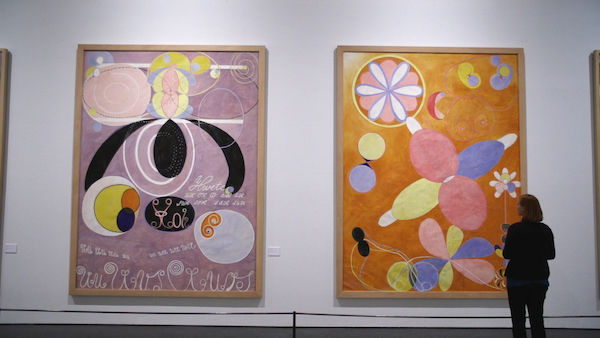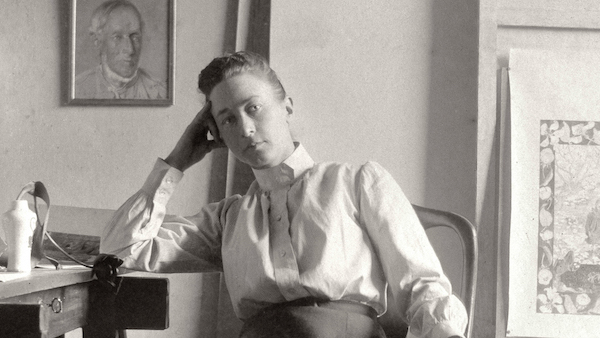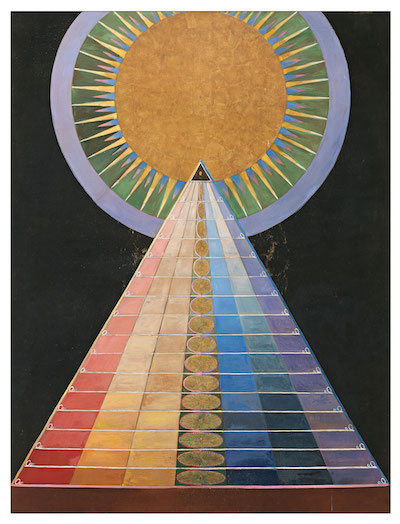Seeing the Unseen & Rewriting Art History

We may not be able to see movies in actual theaters these days and the release dates of many films have been pushed back, but some distributors are working around our current COVID-19 lockdown.
Arthouse and international film distributor Kino Lorber has recently expanded its virtual theatrical exhibition program Kino Marquee into 150 theaters nationwide. This streaming initiative enables local movie theaters shuttered by the coronavirus outbreak to continue serving their audiences while generating some revenue. Film lovers are able watch spring releases while supporting their favorite theater.
Opening on Friday through the websites of various theaters across the country is Beyond the Visible: Hilma af Klint, Halina Dyrschka’s documentary about the revolutionary Swedish artist. What a great time to immerse oneself in the fantastical world and stunning visuals of af Klint’s work. On the other hand, it’s unfortunate that the film isn’t get the big-screen release it deserves. (Hopefully in the future?)
Beyond the Visible is foremost a depiction of af Klint’s unusual life, but it’s framed by the bigger issue of her undervaluation and near-anonymity until recently. Though Vasily Kandinsky has generally been credited as the first abstract artist, the film makes clear that af Klint was creating abstract works years earlier. Yet, many in the U.S. had never heard of her until a retrospective was mounted in 2018 at the Guggenheim, an amazing show that drew huge crowds.

Dyrschka calls upon various art critics, historians and curators, as well as Hilma af Klint’s descendants to discuss her unique (to put it mildly) perspective and the ways in which her art has been ignored by the art world. A repeated theme: Is it possible to re-write art history? The answer isn’t exactly a resounding yes.
Af Klint was born in 1862 to an aristocratic family of naval officers in Sweden. Supported in her creative pursuits by her father, she attended Stockholm’s Royal Academy of Fine Arts, where she first channeled her talent into naturalistic, botanical works. Fascinated by the natural world, she breached tradition by painting nudes and refusing to beautify portraits. From early on, she was interested in more than just art; her goal was no less than understanding human existence and life itself. She wanted to show more than the visible. Her extraordinary abstractions were attempts to depict atoms, quantum theory, DNA, and other biological and scientific processes.

Like many of her era, especially women, she became interested in spirituality, attending seances and other gatherings of like-minded seekers. Female artists have traditionally been underrepresented in the art world; the fact that af Klint was inspired by spiritualism pretty much ensured that her work would be kept out of museums. The film disputes various assertions that she did not exhibit in her lifetime, another excuse given by museum curators to ignore her paintings. Upon her death in 1944, af Klint’s nephew Erik inherited an astounding 1,500 paintings and 26,000 book pages of her art. It wouldn’t be until almost 50 years later that the works would come to light and the artist recognized as the pioneer she was.
Beyond the Visible is generous with af Klint’s eye- and mind-boggling art, presenting a vast array of her paintings both on their own and in gallery settings. From the huge, luminous, pastel-hued “The Ten Largest” series to smaller, monochromatic schematic works, her works are both beautiful and mysterious, spanning decades and themes. It’s clear that she not only had an utterly unique vision—or visions—but she worked tirelessly to bring them to life. Whether she’ll ever get the credit she deserves is another story.
Beyond the Invisible: Hilma af Klint opens on Friday, April 17. Click here to access the film and support local theaters.
—Marina Zogbi

